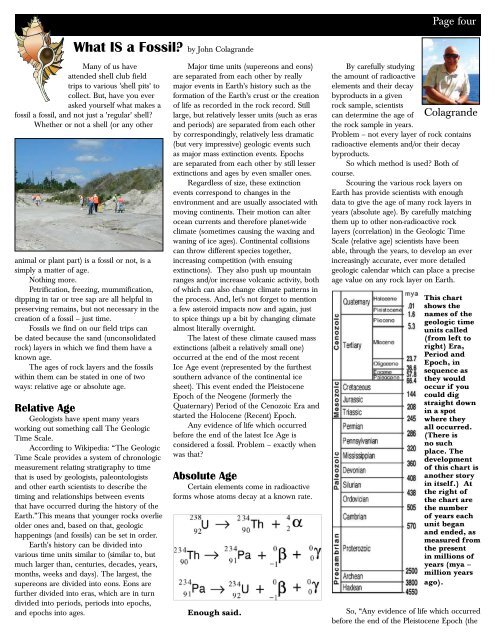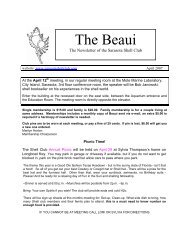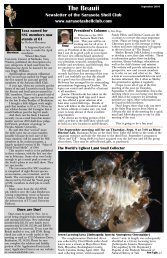You also want an ePaper? Increase the reach of your titles
YUMPU automatically turns print PDFs into web optimized ePapers that Google loves.
Page fourWhat IS a Fossil? by John ColagrandeMany of us haveattended shell club fieldtrips to various 'shell pits' tocollect. But, have you everasked yourself what makes afossil a fossil, and not just a 'regular' shell?Whether or not a shell (or any otheranimal or plant part) is a fossil or not, is asimply a matter of age.Nothing more.Petrification, freezing, mummification,dipping in tar or tree sap are all helpful inpreserving remains, but not necessary in thecreation of a fossil – just time.Fossils we find on our field trips canbe dated because the sand (unconsolidatedrock) layers in which we find them have aknown age.<strong>The</strong> ages of rock layers and the fossilswithin them can be stated in one of twoways: relative age or absolute age.Relative AgeGeologists have spent many yearsworking out something call <strong>The</strong> GeologicTime Scale.According to Wikipedia: “<strong>The</strong> GeologicTime Scale provides a system of chronologicmeasurement relating stratigraphy to timethat is used by geologists, paleontologistsand other earth scientists to describe thetiming and relationships between eventsthat have occurred during the history of theEarth.”This means that younger rocks overlieolder ones and, based on that, geologichappenings (and fossils) can be set in order.Earth's history can be divided intovarious time units similar to (similar to, butmuch larger than, centuries, decades, years,months, weeks and days). <strong>The</strong> largest, thesupereons are divided into eons. Eons arefurther divided into eras, which are in turndivided into periods, periods into epochs,and epochs into ages.Major time units (supereons and eons)are separated from each other by reallymajor events in Earth's history such as theformation of the Earth's crust or the creationof life as recorded in the rock record. Stilllarge, but relatively lesser units (such as erasand periods) are separated from each otherby correspondingly, relatively less dramatic(but very impressive) geologic events suchas major mass extinction events. Epochsare separated from each other by still lesserextinctions and ages by even smaller ones.Regardless of size, these extinctionevents correspond to changes in theenvironment and are usually associated withmoving continents. <strong>The</strong>ir motion can alterocean currents and therefore planet-wideclimate (sometimes causing the waxing andwaning of ice ages). Continental collisionscan throw different species together,increasing competition (with ensuingextinctions). <strong>The</strong>y also push up mountainranges and/or increase volcanic activity, bothof which can also change climate patterns inthe process. And, let's not forget to mentiona few asteroid impacts now and again, justto spice things up a bit by changing climatealmost literally overnight.<strong>The</strong> latest of these climate caused massextinctions (albeit a relatively small one)occurred at the end of the most recentIce Age event (represented by the furthestsouthern advance of the continental icesheet). This event ended the PleistoceneEpoch of the Neogene (formerly theQuaternary) Period of the Cenozoic Era andstarted the Holocene (Recent) Epoch.Any evidence of life which occurredbefore the end of the latest Ice Age isconsidered a fossil. Problem – exactly whenwas that?Absolute AgeCertain elements come in radioactiveforms whose atoms decay at a known rate.Enough said.By carefully studyingthe amount of radioactiveelements and their decaybyproducts in a givenrock sample, scientistscan determine the age of Colagrandethe rock sample in years.Problem – not every layer of rock containsradioactive elements and/or their decaybyproducts.So which method is used? Both ofcourse.Scouring the various rock layers onEarth has provide scientists with enoughdata to give the age of many rock layers inyears (absolute age). By carefully matchingthem up to other non-radioactive rocklayers (correlation) in the Geologic TimeScale (relative age) scientists have beenable, through the years, to develop an everincreasingly accurate, ever more detailedgeologic calendar which can place a preciseage value on any rock layer on Earth.This chartshows thenames of thegeologic timeunits called(from left toright) Era,Period andEpoch, insequence asthey wouldoccur if youcould digstraight downin a spotwhere theyall occurred.(<strong>The</strong>re isno suchplace. <strong>The</strong>developmentof this chart isanother storyin itself.) Atthe right ofthe chart arethe numberof years eachunit beganand ended, asmeasured fromthe presentin millions ofyears (mya –million yearsago).So, “Any evidence of life which occurredbefore the end of the Pleistocene Epoch (the





